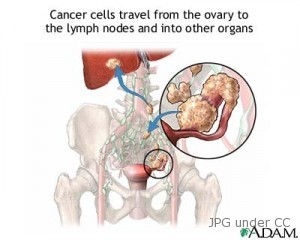Ovarian Cancer facts

Ovarian Cancer OVERVIEW
Ovarian cancer is considered one of the most common cancerous disease of women today. It ranks fifth among a huge list of cancers known to have caused death of many people in the world. Prognosis of this cancer is hard to tell because the ovaries are buried deep within the abdominal cavity, making it difficult to examine. It is for this reason why ovarian cancer is often discovered at a later stage.
Screening tests for ovarian cancer are currently unavailable. Symptoms appear at a later stage and almost too late to treat, hence, tagging a nickname as a “silent killer”. Should symptoms occur, most of them resemble other medical conditions, which make a diagnosis of this cancer difficult. But a recent study shows that this kind of cancer can be prevented through a regular pelvic and vaginal exam to check if there are changes in the ovaries.
TYPES AND FORMS
The types of ovarian cancer are classified according to the tumors formed in the ovarian tissues.
Germ Cell Tumors : These are ovarian tumors that are developed in the egg-producing tissue of the ovaries. This type of ovarian cancer is often detected in young women and this can be treated effectively at early stages. An approximately 5% of women were diagnosed with germ cell tumors.
Stromal tumor : These ovarian tumors start to form in the connective tissue which is responsible in holding the ovaries together and at the same time produce the female hormones, known as: estrogen and progesterone.
Women over the age of 50 are often found with this type of ovarian cancer, but it can also be found in young women. This cancer type may show symptoms such as vaginal bleeding in menopausal women, and in young women who have their menstrual periods and breast development.
Epithelial tumors : These ovarian tumors, also referred to as carcinomas, are formed in the epithelial tissue responsible in covering the ovaries. This is the most common type of ovarian cancer and is further classified into four categories: mucinous, serous, endometrioid, mucinous, and clear cell types. These tumors are primarily formed in adults.
These tumors are also classified according to a three-grade scale. During the first grade, ovarian cancer of this type shows a normal appearance and can be treated more effectively. The third grade epithelial tumors, however, show a less normal tissue and have a worse prognosis.
SYMPTOMS
The symptoms of ovarian cancer are often noticed at a later stage when cancer mass is already growing large. But there are also women who are experiencing pain in their pelvic at the early stages of their cancer. These women, however, tend to ignore the symptom as it is vague and they only associate it to common benign health conditions.
Initial symptoms of ovarian cancer include the stomach experiencing pressure, bloating, pain or discomfort due to fluid buildup within the body’s abdominal cavity. The lungs might also accumulate the said fluid, causing difficulty of breathing when cancer cells spreads to the diaphragm. All these can result to lose of appetite or the cancer patient experiences the feeling of fullness after eating a very light meal.
When the ovarian tumor starts to exert pressure on the bladder, the cancer patient may experience constipation, diarrhea, gas, nausea, vomiting, or frequent urination. Pain in the pelvic area and pain during intercourse is also experienced. Some symptoms that are seldom experienced are fever, unexplained weight gain or weight loss, vaginal bleeding, changes in bowel habits, and abnormal fatigue.
RISK FACTORS
The exact cause of ovarian cancer is unknown, but medical researches have identified risk factors that can make a woman susceptible to ovarian cancer. According to research and statistics, women over the age of fifty or those at the post-menopausal stage are susceptible to cancer of the ovary. Caucasian women are more susceptible to ovarian cancer than African American women. Women who have suffered from breast cancer have a higher chance of developing cancer of the ovary due to a mutated BRCA gene. It can also be hereditary due to the inherited BRCA1 and BRCA2 genes.
Post-menopausal women who had a hormone replacement therapy have a higher risk of developing this disease. An increased risk factor of getting this cancer is for women who never had children or those women who gave birth after the age of thirty. The rationale behind this is that the number of menstrual cycles a woman has is one big factor that affects the chances of developing this cancer. Women who have an intake of fertility drugs are three times more likely to develop an ovarian cancer than those who do not use any fertility drugs.
TREATMENTS
Treatment of ovarian cancer normally depends on the stage of the disease. Here are the suggested treatments for the following stages:
STAGE 1A and STAGE 1B:
- Surgical removal of the two ovaries, uteruses and fallopian tubes.
- Partial removal of the omentum.
- Surgical staging of the patient’s lymph ovaries and other pelvic and abdominal tissues.
STAGE 1C – ovarian cancer patients undergo a platinum-based chemotherapy to prevent relapsing.
STAGE II:
- Total hysterectomy
- Bilateral salpingo-oophorectomy
- Tumor debulking or the removal of cancer affected areas in the pelvic area.
- Post-surgery chemotherapy
STAGE III:
- Total hysterectomy
- Tumor debulking
- Post-surgery chemotherapy
STAGE IV: Patient undergoes tumor debulking prior to chemotherapy, which is considered as a mainstay treatment since recurrent ovarian cancer may take place in this stage.
